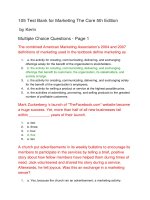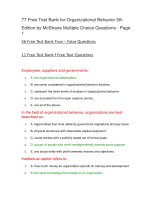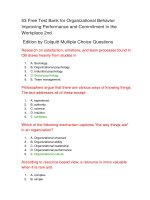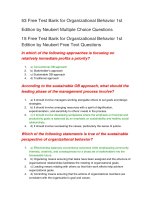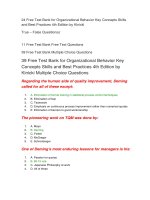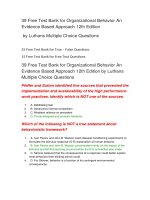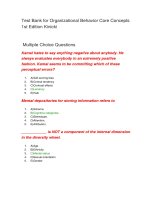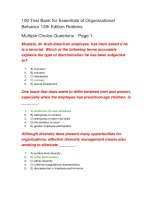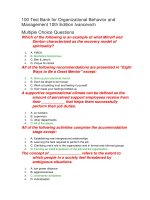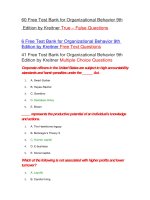105 test bank for organizational behavior essentials 2nd edition mcshane đề thi trắc nghiệm
Bạn đang xem bản rút gọn của tài liệu. Xem và tải ngay bản đầy đủ của tài liệu tại đây (158.62 KB, 28 trang )
105 Test Bank for Organizational Behavior Essentials
2nd Edition McShane
Multiple Choice Questions - Page 1
All technical employees at a paper mill take a course on how to operate a
new paper-rolling machine. This course will improve job performance
mainly by altering employee:
1.
A. aptitudes
2.
B. role perceptions
3.
C. motivation
4.
D. organizational citizenship
5.
E. learned capabilities
Competencies relate most closely to which element in the MARS model of
behavior and performance?
1.
A. Motivation
2.
B. Situational factors
3.
C. Role perceptions
4.
D. Ability
5.
E. Competencies are not related at all to any element of the MARS model
Most employees in the social services section of a government
department have frequent interaction with people who are unemployed or
face personal problems. Which of the following personality characteristics
is best suited to employees working in these jobs?
1.
A. High neuroticism
2.
B. External locus of control.
3.
C. High introversion.
4.
D. High agreeableness.
5.
E. Both ‘B' and ‘C'.
Conscientiousness is one dimension of:
1.
A. the MARS model.
2.
B. Schwartz's values model.
3.
C. Myers-Briggs Type Indicator
4.
D. all of the above.
5.
E. none of the above.
______ are the natural talents that help employees learn specific tasks
more quickly and perform them better.
1.
A. Persistence
2.
B. Direction
3.
C. Intensity
4.
D. Aptitude
5.
E. Competencies
All of these factors directly influence an employee's voluntary behavior
and performance EXCEPT:
1.
A. motivation.
2.
B. role perceptions.
3.
C. situational factors.
4.
D. moral intensity.
5.
E. ability.
Neuroticism is explicitly identified in:
1.
A. the MARS model.
2.
B. Schwartz's values model.
3.
C. ‘Big Five' personality dimensions.
4.
D. Holland's theory of vocational choice.
5.
E. both ‘A' and ‘C'.
Which of these refers to a person's beliefs about what behaviors are
appropriate or necessary in a particular situation?
1.
A. Natural aptitudes
2.
B. Role perceptions
3.
C. Competencies
4.
D. Locus of control
5.
E. Situational factors
______ is the amount of effort allocated to the goal.
1.
A. Persistence
2.
B. Direction
3.
C. Intensity
4.
D. Aptitude
5.
E. Competencies
Which of these factors directly influences an employee's voluntary
behavior and performance?
1.
A. Motivation
2.
B. Role perceptions
3.
C. Uncertainty avoidance
4.
D. All of the above
5.
E. Only ‘A' and ‘B'
Companies can improve employee performance through situational
factors by:
1.
A. asking employees about the things that motivate them.
2.
B. testing employee skills and knowledge before they are hired.
3.
C. providing training so employees learn the required competencies.
4.
D. redesigning the job so employees are only given tasks within their capabilities.
5.
E.asking employees to identify problems they experience with time and resources,
then removing those obstacles to job performance.
According to the MARS model of individual behavior, which of the
following is NOT a role perception problem?
1.
2.
A. The employee lacks the proper tools to perform the job.
B. The employee knows two different ways to perform a particular task, but
unknowingly chooses the
3.
method that the organization does not want its employees to use.
4.
C. The employee doesn't realize that a particular task is part of his or her job.
5.
D. The employee places more emphasis on the quantity of work whereas the
organization wants more emphasis placed on the quality of work.
6.
E. The employee believes that the company wants him or her to spend more time
with clients, whereas the company really wants client requests processed more
quickly.
7.
Q#SWhich of these refers to a person's beliefs about what behaviors are
appropriate or necessary in a particular situation?
Which ‘Big Five' personality dimension is most valuable for predicting job
performance?
1.
A. Extroversion
2.
B. Openness to experience
3.
C. Conscientiousness
4.
D. Neuroticism
5.
E. None of the ‘Big Five' traits predict job performance to any extent
Which of the following ensures that job incumbents have appropriate
aptitudes to perform the job?
1.
A. Hire applicants with appropriate aptitudes.
2.
B. Train employees so they develop appropriate aptitudes.
3.
C. Motivate employees to have appropriate aptitudes.
4.
D. Provide resources that allow employees to perform their jobs.
5.
E. All of the above.
6.
Q#SCompetencies relate most closely to which element in the MARS model of
behavior and performance?
Competencies include:
1.
A. a person's aptitudes.
2.
B. a person's learned abilities.
3.
C. a person's skills.
4.
D. all of the above.
5.
E. none of the above.
The relatively stable pattern of behaviors and consistent internal states
that explain a person's behavioral tendencies refers to
1.
A. personality.
2.
B. values.
3.
C. motivation.
4.
D. locus of control.
5.
E. job satisfaction.
You have just hired several new employees who are motivated, able to
perform their jobs, and have adequate resources. However, they aren't
sure what tasks are included in their job. According to the MARS model,
these new employees will likely:
1.
A. emphasize the utilitarianism principle in their decision making.
2.
B. have lower job performance due to poor role perceptions.
3.
4.
5.
C. have high job performance because they are motivated and able to perform the
work.
D. have above average organizational citizenship.
E. have a high degree of differentiation according to Holland's classification of
occupations.
Ability includes which of these?
1.
A. Aptitudes and learned skills
2.
B. Natural aptitude and intensity
3.
C. Persistence and direction
4.
D. Intensity and learned capabilities
5.
E. Direction and intensity
Motivation affects a person's ______ of voluntary behavior.
1.
A. direction, intensity, and persistence
2.
B. antecedents, consequences and reinforcers
3.
C. size, shape and weight
4.
D. aptitudes, abilities, and competencies
5.
E. agreeableness, locus of control, and ethical sensitivity
The ‘Big Five' personality dimensions are identified by the acronym:
1.
A. MBTIA
2.
B. CANOE
3.
C. VALUE
4.
D. MARSE
5.
E. HAPPY
An individual's personality:
1.
A. changes several times throughout the year.
2.
B. is formed only from childhood socialization and the environment.
3.
C.is less evident in situations where social norms, reward systems, and other
conditions constrain behavior.
4.
D. is all of the above.
5.
E. is only ‘B' and ‘C'.
_______ represents the forces within a person that affect the direction,
intensity, and persistence of voluntary behavior.
1.
A. Motivation
2.
B. Personality
3.
C. Values
4.
D. Ethics
5.
E. Ability
Aptitudes, skills, and competencies all fall under which of the following
concepts?
1.
A. Motivation
2.
B. Personality
3.
C. Values
4.
D. Ethics
5.
E. Ability
The ‘Big Five' personality dimensions represent:
1.
A. all of the personality traits found in an ideal job applicant.
2.
B. the aggregated clusters representing most known personality traits.
3.
C. the personality traits caused by the environment rather than heredity.
4.
D. all of the above.
5.
E. only ‘B' and ‘C'.
6.
Q#SThe ‘Big Five' personality dimensions are identified by the acronym:
To reduce the amount of non-recyclable waste that employees throw out
each day, a major computer company removed containers for nonrecyclable rubbish from each office and workstation. This altered
employee behavior mainly by:
1.
A. increasing employee motivation to be less wasteful.
2.
B. helping employees to learn how to be less wasteful.
3.
C. altering situational factors so that employees have more difficulty practicing
wasteful behavior.
4.
D. increasing aptitudes that make employees less wasteful.
5.
E. increasing organizational citizenship so that employees will be less wasteful.
Which of the following refers to the fact that motivation is goal-directed,
not random?
1.
A. Persistence
2.
B. Direction
3.
C. Intensity
4.
D. Aptitude
5.
E. Competencies
Which of the following identifies the four factors that directly influence
individual behavior and performance?
1.
A. Utilitarianism
2.
B. MARS model
3.
C. Schwartz's model
4.
D. Holland's model
5.
E. Myers-Briggs Type Indicator
6.
Q#SWhich of these factors directly influences an employee's voluntary behavior
and performance?
Travel Happy Corp. gives simple accounts to newly hired employees, and
then adds more challenging accounts as employees master the simple
tasks. This practice mainly:
1.
A. improves role perceptions.
2.
B. increases person-job matching.
3.
C. reduces employee motivation.
4.
D. provides more resources to accomplish the assigned task.
5.
E. improves employee aptitudes.
________ characterizes people with high levels of anxiety, hostility,
depression, and self-consciousness.
1.
A. Extroversion
2.
B. Openness to experience
3.
C. Conscientiousness
4.
D. Neuroticism
5.
E. Agreeableness
Being good-natured, empathetic, caring, and courteous are characteristic
of people with which personality trait?
1.
A. Openness to experience
2.
B. Agreeableness
3.
C. Locus of control
4.
D. Emotional stability
5.
E. Extroversion
The MARS model explicitly identifies which of the following factors?
1.
A. Money
2.
B. Recreational activities
3.
C. Neuroticism
4.
D. Situational factors
5.
E. All of the above
66 Free Test Bank for Organizational Behavior
Essentials 2nd Edition McShane Multiple Choice
Questions - Page 2
Ethical decision making should consider whether:
1.
A. the decision outcomes will provide the greatest good for the greatest number.
2.
B. the implementation of the preferred choice violates any government laws.
3.
C. people affected by the decision believe that the results of decision
implementation are fair.
4.
D. all of the above.
5.
E. only ‘A' and ‘B'.
People with high collectivism:
1.
A. accept unequal distribution of power
2.
B. also have low individualism.
3.
C. value harmonious relationships in the groups to which they belong.
4.
D. value thrift, savings, and persistence.
5.
E. have both ‘B' and ‘C'.
Which of the following represents values that determine whether actions
are right or wrong and outcomes are good or bad?
1.
A. Conscientiousness
2.
B. Sensing
3.
C. Moral intensity
4.
D. Self-monitoring
5.
E. Ethics
Schwartz's values model includes all of the following EXCEPT:
1.
A. Universalism.
2.
B. Hedonism.
3.
C. Security.
4.
D. Utilitarianism.
5.
E. Self-direction.
______ is the extent to which we value our duty to groups to which we
belong and group harmony.
1.
A. Individualism
2.
B. Collectivism
3.
C. Power distance
4.
D. Uncertainty avoidance
5.
E. Achievement orientation
All of these are "Big Five" personality dimensions EXCEPT:
1.
A. openness to experience.
2.
B. agreeableness.
3.
C. locus of control.
4.
D. emotional stability.
5.
E. extroversion.
6.
Q#SExtroversion is one dimension of:
Beliefs about what is good or bad, right or wrong are called:
1.
A. organizational citizenship.
2.
B. values.
3.
C. collectivism.
4.
D. moral intensity.
5.
E. extroversion.
The ability to recognize the presence and determine the relative
importance of an ethical issue is known as:
1.
A. neuroticism.
2.
B. moral intensity.
3.
C. ethical sensitivity.
4.
D. utilitarianism.
5.
E. uncertainty avoidance.
6.
Q#Se-Commerce International is fast growing small company specializing in the
consumer electronics. Managers at e-Commerce International are exploring the
idea of using the Big Five Personality Dimensions in hiring and improving workrelated behaviors and job performance. All of these are "Big Five" personality
dimensions EXCEPT:
______ is the extent to which people tolerate ambiguity or feel threatened
by ambiguity.
1.
A. Individualism
2.
B. Collectivism
3.
C. Power distance
4.
D. Uncertainty avoidance
5.
E. Achievement orientation
Etoni is a new employee who comes from a culture that values respect for
people in higher positions and values the wellbeing of others more than
goal achievement. Etoni's culture would have:
1.
A. high power distance and nurturing orientation.
2.
B. high collectivism and short-term orientation.
3.
C. low uncertainty avoidance and high individualism.
4.
D. low power distance and strong nurturing orientation.
5.
E. none of the above.
Senior executives at CyberForm must make a decision that will affect
many people and where the decision may produce good or bad
consequences for those affected. This decision:
1.
2.
A. has a high degree of ethical sensitivity.
B. is one in which decision makers should rely only on the utilitarianism rule of
ethics.
3.
C. has a low degree of ethical sensitivity.
4.
D. has a high degree of moral intensity.
5.
E. requires a low duty to care.
6.
Q#SPeople who have high ethical sensitivity:
Americans tend to have:
1.
A. a high collectivism value orientation.
2.
B. a high nurturing-orientation value.
3.
C. a long-term orientation.
4.
D. an individualistic value orientation.
5.
E. both ‘B' and ‘C'.
All of the following are domains in Schwartz's values model EXCEPT:
1.
A. tradition.
2.
B. power.
3.
C. conscientiousness.
4.
D. conformity.
5.
E. stimulation.
6.
Q#SSchwartz's values model includes all of the following EXCEPT:
Incongruence between a company's dominant values and an employee's
values is known to:
1.
A. increase employee stress.
2.
B. increase the employee's probability of quitting.
3.
C. increase the chance that the employee's decisions will differ from the
organization's preferences.
4.
D. do all of the above.
5.
E. have no effect on employee behavior or decision making.
Extroversion is one dimension of:
1.
A. the MARS model.
2.
B. Schwartz's values model.
3.
C. the Venus theory.
4.
D. ‘Big Five' personality dimensions.
5.
E. none of the above.
In the section on cross-cultural values, the textbook warns that:
1.
A.the cross-cultural data presented are based on a very small sample (less than
10 people in each country studied).
2.
B.the definitions of most values have changed over the past decade, so most
cross-cultural information has little meaning anymore.
3.
C. several cultures don't have any values, but this isn't mentioned in the literature.
4.
D. diverse societies such as the United States have a wide range of values even
though the information presented assumes that everyone in the country has similar
values.
5.
E. all of the above.
Which of the following is NOT identified in the textbook as an ethical
principle?
1.
A. Utilitarianism
2.
B. Distributive justice
3.
C. Moral intensity
4.
D. Individual rights
5.
E. All of these are ethical principles identified in the textbook.
Which of the following countries generally has high achievement
orientation values?
1.
A. United States
2.
B. Russia
3.
C. Japan
4.
D. Sweden
5.
E. The Netherlands
One problem with the utilitarian principle of ethical decision making is
that:
1.
2.
A. not all utilitarian rights are protected by law.
B. there is no agreement on what activities are the greatest benefit to the least
well off.
3.
C. it is difficult to predict the ‘trickle down' benefits to the least well off in society.
4.
D. it is almost impossible to evaluate the benefits or costs of many decisions.
5.
E. the utilitarian principle is not really a valid ethical principle at all.
________ characterizes people with high levels of anxiety, hostility,
depression, and self-consciousness.
1.
A. Extroversion
2.
B. Openness to experience
3.
C. Conscientiousness
4.
D. Neuroticism
5.
E. Locus of control
Schwartz's model organizes ____ into ______.
1.
A. personality traits, six dimensions.
2.
B. values, a hierarchy.
3.
C. needs, three statistical formulas
4.
D. values, ten broader domains.
5.
E. emotions, a time line.
e-Commerce International is fast growing small company specializing in
the consumer electronics. Managers at e-Commerce International are
exploring the idea of using the Big Five Personality Dimensions in hiring
and improving work-related behaviors and job performance.Being goodnatured, empathetic, caring, and courteous are characteristic of people
with which personality trait?
1.
A. Openness to experience
2.
B. Agreeableness
3.
C. Locus of control
4.
D. Emotional stability
5.
E. Extroversion
Which of these countries generally has the strongest collectivist value
orientation?
1.
A. United States
2.
B. Japan
3.
C. Taiwan
4.
D. Egypt
5.
E. France
People who have high ethical sensitivity:
1.
A. are always more ethical than people with a moderate or low level of ethical
sensitivity.
2.
B. tend to have higher empathy.
3.
C. tend to have more information about the specific situation.
4.
D. are all of the above.
5.
E. are only ‘B' and ‘C'.
People with a high ______ value assertiveness, competitiveness, and
materialism.
1.
A. individualism
2.
B. collectivism
3.
C. power distance
4.
D. uncertainty avoidance
5.
E. achievement orientation
Which of the following statements about values is FALSE?
1.
A. Values help define what is right or wrong and good or bad in the world.
2.
B. Values are arranged into a hierarchy of preferences.
3.
C. The values that dominate a person's preferences differ across cultures.
4.
D. Values guide our decisions and actions.
5.
E. A person's hierarchy of values typically changes a few times each year.
e-Commerce International is fast growing small company specializing in
the consumer electronics. Managers at e-Commerce International are
exploring the idea of using the Big Five Personality Dimensions in hiring
and improving work-related behaviors and job performance. All of these
are "Big Five" personality dimensions EXCEPT:
1.
A. openness to experience.
2.
B. agreeableness.
3.
C. locus of control.
4.
D. emotional stability.
5.
E. extroversion.
________ characterizes people who are quiet, shy, and cautious.
1.
A. Introversion
2.
B. Openness to experience
3.
C. Conscientiousness
4.
D. Neuroticism
5.
E. Agreeableness
Employees from cultures with a high power distance are more likely to:
1.
A. use their existing power to gain more power.
2.
B. encourage consensus-oriented decision making.
3.
C. avoid people in positions of power.
4.
D. readily accept the high status of other people in the organization.
5.
E. give their power to others as a sign of friendship.
6.
Q#SAmericans tend to have:
Which ‘Big Five' personality dimension is most valuable for predicting job
performance?
1.
A. Extroversion
2.
B. Openness to experience
3.
C. Conscientiousness
4.
D. Neuroticism
5.
E. Locus of control
Which of the following statements about cross-cultural values is TRUE?
1.
A. People with a high achievement-orientation emphasize relationships and the
well-being of others.
2.
B. People with high individualism can have any level (high or low) of collectivism.
3.
C. People with high power distance value independence and personal uniqueness
4.
D. People with low uncertainty avoidance must also have high power distance.
5.
E. People in almost all cultures have high uncertainty avoidance.
People who value their independence and personal uniqueness have:
1.
A. high individualism.
2.
B. high collectivism.
3.
C. high power distance.
4.
D. low uncertainty avoidance.
5.
E. both ‘A' and ‘B'.
Which of the following is an ethical principle that people have entitlements
that let them act in a certain way?
1.
A. Utilitarianism
2.
B. Individual rights
3.
C. Moral intensity
4.
D. Distributive justice
5.
E. Care
Ethics is most closely related to:
1.
A. values.
2.
B. locus of control.
3.
C. the Myers-Briggs type Indicator.
4.
D. personality.
5.
E. ability.
6.
Q#SWhich of the following represents values that determine whether actions are
right or wrong and outcomes are good or bad?
The main limitation of the individual rights principle is that:
1.
A. it really isn't an ethical principle at all
2.
B. some individual rights conflict with other individual rights.
3.
C.it pays attention to whether consequences are ethical, but not to whether the
means to those consequences are ethic.
4.
D.it is almost impossible to evaluate the benefits or costs of decisions when many
stakeholders are affected.
5.
E. it can degenerate into unjust favoritism
True - False Questions
(p. 28)Learned capabilities refer to the skills and knowledge that you have
actually acquired.
1.
True
2.
False
(p. 26)According to the MARS model of individual behavior and
performance, employee performance will remain high even if one of the
four factors significantly weakens.
1.
True
2.
False
(p. 40)The distributive justice principle of ethical decision making people
who are similar in relevant ways should receive dissimilar benefits and
burdens based on their individual rights.
1.
True
2.
False
(p. 28)Competencies refer to goal-directed behaviors under the
individual's control that support organizational objectives.
1.
True
2.
False
(p. 30)People with a high score on the neuroticism personality dimension
tend to be more relaxed, secure and calm.
1.
True
2.
False
(p. 29)Personality is a relatively stable pattern of behaviors and internal
states that explains a person's behavioral tendencies.
1.
True
2.
False
(p. 36-37)Our habitual behavior tends to be consistent with our values, but
our everyday conscious decisions and actions apply our values much
less consistently.
1.
True
2.
False
(p. 36)One dimension of Schwartz's values model has openness to change
at one extreme and conservation at the other extreme.
1.
True
2.
False
(p. 38)Cultures with high collectivism must also have low individualism.
1.
True
2.
False
(p. 30)Agreeableness, extroversion, and conscientiousness are three of
the ‘Big Five' personality dimensions.
1.
True
2.
False
(p. 37)Perfect person-organization value congruence is possible but not
desirable.
1.
True
2.
False
(p. 29,35)Two of the most stable individual differences are values and
personality.
1.
True
2.
False
(p. 35)Corporate leaders have a strong influence on the moral conduct of
employees in that organization.
1.
True
2.
False
(p. 38)Two countries with low collectivism are Japan and the United
States.
1.
True
2.
False
(p. 28)Research has found that absenteeism is rarely, if ever, caused by
situational factors.
1.
True
2.
False
(p. 40)Ethical sensitivity is the degree to which an issue demands the
application of ethical principles.
1.
True
2.
False
(p. 40)Ethically sensitive people recognize the presence and determine the
relative importance of an ethical issue.
1.
True
2.
False
(p. 30)The ‘Big Five' personality dimensions represent five clusters that
represent most personality traits.
1.
True
2.
False
(p. 39)Three personality traits are care, utilitarianism, and distributive
justice.
1.
True
2.
False
(p. 30)Conscientiousness refers to the extent that people are sensitive,
flexible, creative, and curious.
1.
True
2.
False
p. 28)Companies can improve employee role perceptions by describing
the employee's assigned tasks clearly and providing meaningful
performance feedback.
1.
True
2.
False
(p. 35)Values are stable, evaluative beliefs about what is important in a
variety of situations.
1.
True
2.
False
(p. 27)Ability is the most important factor in the MARS model to explain
why people quit their jobs.
1.
True
2.
False
(p. 38)In terms of cross-cultural values, Americans tend to have relatively
high individualism with an achievement orientation and low power
distance.
1.
True
2.
False
(p. 26)Intensity refers to the fact that motivation is goal-directed, not
random.
1.
True
2.
False
(p. 37)The ideal situation in organizations is to have employees whose
values are perfectly congruent with the organization's values.
1.
True
2.
False
(p. 40)Ethics experts say that the most effective way to ensure that
employees engage in ethical behavior is to introduce ethical codes of
conduct.
1.
True
2.
False
(p. 39)One problem with applying the individual rights principle of ethical
decision making is that one individual right may conflict with another.
1.
True
2.
False
